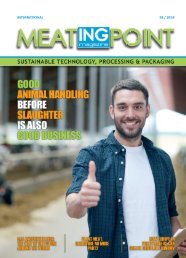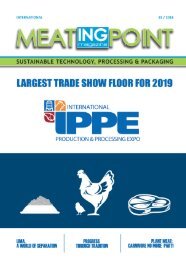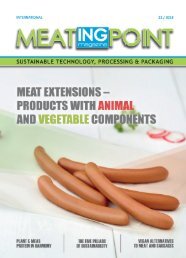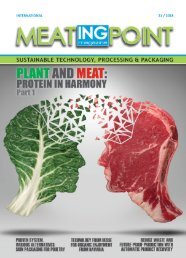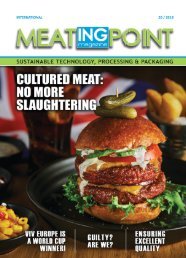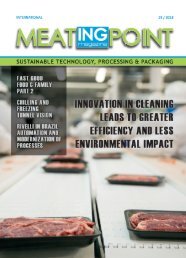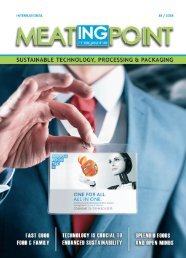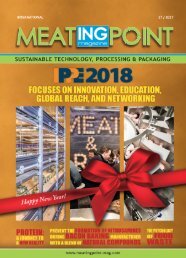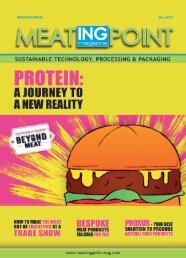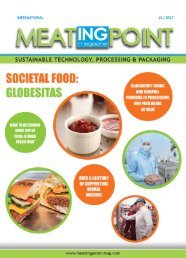MEATing POINT Magazine: #08/ 2016
You also want an ePaper? Increase the reach of your titles
YUMPU automatically turns print PDFs into web optimized ePapers that Google loves.
PACKAGING<br />
THE KEY TO SEALING SUCCESS<br />
Ongoing pack developments require equipment flexibility,<br />
explains Tony Burgess of Proseal<br />
The growth in popularity of skin packs and<br />
other new formats for meat and poultry<br />
products, such as MAP gas flushing and<br />
Vacuum MAP sealing, is creating additional<br />
challenges for equipment suppliers.<br />
Skin packs feature a special film<br />
that seals to all surfaces of a tray –<br />
rim, sidewalls and base – to tightly<br />
cover the entire contents. The packs<br />
were first adopted primarily for<br />
fish products but are now being<br />
increasingly seen for other types<br />
of foods such as ready to cook<br />
meals, game, meat and sausage<br />
products, and mini joints.<br />
Skin packing comes in a number of formats<br />
- skin below and above the flange, and Skin<br />
Deep, which allows a 100mm protrusion of<br />
product over the top of the tray.<br />
Such developments have led to many meat<br />
processors experimenting with pack formats,<br />
particularly for new products. At the same<br />
time it is imperative that, while exploring these<br />
options, they are still able to maintain current<br />
production. In addition, the proliferation of<br />
new products means many manufacturers<br />
now have to be able to handle a variety of<br />
different packs on their lines.<br />
For this reason, an element of futureproofing<br />
is vital in the development<br />
of new tray sealers, so that food<br />
manufacturers have the reassurance<br />
of knowing that they will have the<br />
capability to handle the latest<br />
packing trend without the need to<br />
invest in new kit every time.<br />
Our latest models, for example, can<br />
handle all of the above-mentioned<br />
sealing formats, and these options<br />
can be added at any time, and<br />
even removed if required. This<br />
gives manufacturers the flexibility<br />
easily to switch between packs<br />
during normal production, or to<br />
run trial packs.<br />
In addition, as we develop new<br />
features in line with new customer<br />
requirements, we ensure that these<br />
can also be retrofitted to models<br />
already out on the production floor.<br />
In terms of line speeds, the introduction of<br />
new technologies such as following motion<br />
and intelligent buffering, which enable trays<br />
to feed continuously into a tray sealer without<br />
having to pre-sort and adjust pack spacing,<br />
have helped to increase speeds. They also<br />
improve product handling since there are<br />
fewer line stoppages due to misplaced trays.<br />
Meanwhile, the availability of online<br />
monitoring of equipment and the ability to<br />
collect data on small but unscheduled line<br />
stoppages can help production managers<br />
and engineers identify recurring problems<br />
and implement corrective action to maximise<br />
line uptime.<br />
Both of these developments also<br />
underline the importance of developing<br />
fully integrated packing lines, where<br />
individual pieces of equipment are<br />
linked together to help maximise<br />
efficiencies and which can be tailored<br />
to the precise needs of individual<br />
products.<br />
The meat market remains very fastmoving<br />
and competitive. Machinery<br />
suppliers need therefore to be able to<br />
respond just as quickly to both current and<br />
future trends.<br />
www.proseal.com<br />
issue 8 | www.meatingpoint-mag.com<br />
33








